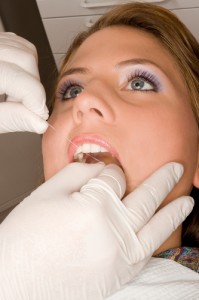Calendar
May 2024 M T W T F S S « Jun 1 2 3 4 5 6 7 8 9 10 11 12 13 14 15 16 17 18 19 20 21 22 23 24 25 26 27 28 29 30 31 -
Recent Posts
Recent Comments
Archives
Categories
Gum Disease
Periodontal Disease Stages
It is estimated that more than half of all adults age 35 and older have early to advanced stages of periodontal disease. Periodontal disease (PD) is the primary cause of lost teeth after the age of 35 – not dental cavities!

What is periodontal disease ?
Periodontal disease is a chronic gum infection caused by plaque resulting in loss of bone support around the roots of teeth. Plaque is a thin film of bacteria that forms on teeth. Plaque converts to tartar if not cleared form teeth after 24hrs. Tartar irritates gums leaving them red, swollen and bleeding readily.
Eventually the gums peel away form teeth and create small pockets between the teeth and gums, slowly continuing to also destroy the supporting bone. Severe loss of the supporting bone is what loosens up teeth and make them incapable of functioning properly. Periodontal disease is often painless and will go undetected until bone loss is so severe that teeth are so loose they need to be extracted.
What are the signs ?
Early Stages:
• Bleeding gums when you brush or floss
• Red, swollen, tender gums
• Gums that have receded or shrunken away from teeth
Later Stages:
• Loose teeth, or teeth that have moved, or more spacing between teeth (especially front teeth) resulting in changes in bite or in the fit of dentures
• Foul smell or taste and/or pus that can be expelled when pressing on the gums
What can you do ?
The best way to treat periodontal disease is by early detection and prevention. A thorough examination can tell if you are at risk. Once diagnosed with periodontal disease, one must try to prevent further loss of supporting bone and/or other teeth.
Treatment usually involves a thorough scaling and root planing to remove plaque and built up tartar, thus allowing healthy gums tissues to reattach to root surfaces of teeth. Clean surfaces of teeth must be maintained by meticulous home oral hygiene and routine check-ups and cleaning.
Remember: There is really no cure for this “silent tooth killer”; cleanings can only dramatically slow down the disease process. Only early detection and prevention can make the difference between premature loss of teeth and a full compliment of healthy strong teeth.
Source: http://www.drchoo.com/images/preventive04.gif
Posted in Gum Disease, Periodontal Disease
Leave a comment
Waterpik vs Floss
Pros & Cons: Floss
Dental floss is an inexpensive way to help keep your teeth and gums healthy. MayoClinic.com indicates that floss is effective for cleaning tight spaces between teeth and will also scrape up and down the sides of each tooth. This is important because if plaque is not removed it can become tarter, a risk factor for the early stage of gum disease called gingivitis, according to the ADA.
On the other hand, the mechanical nature of floss can be abrasive. “Flossing can be irritating for people who have sensitive gums and may actually cause bleeding in some people,” Hayes notes. Also floss can’t be used by people who wear braces because it won’t penetrate the wires in order to reach the gums, Hayes adds.
Pros And Cons: Waterpik
One benefit of a Waterpik is that it’s gentle on the gums and is less likely to cause bleeding in people with sensitive gums, according to Hayes. A Waterpic is also ideal for people who wear braces — water will get behind the metal wires and flush out food particles. A Waterpik is sometimes recommended for people who have active gum disease because it flushes out bacteria from deep pockets that form when gums pull away from the teeth. “Floss can’t reach these pockets,” Hayes says. The downside: A Waterpik doesn’t remove plaque from teeth as well as floss. “Flossing scrapes off the sticky film of bacteria, while a Waterpic just rinses it,” Hayes explains. MayoClinic.com says using a Waterpik isn’t a substitute for flossing.
Source: http://www.livestrong.com/article/287399-waterpik-vs-floss/
Posted in Gum Disease, Periodontal Disease
Leave a comment
Animals have problems with their teeth too!
Not only do humans get periodontal disease but animals can too. I found out that most wild animals avoid major dental problems simply just by dying before their teeth go bad. Wild animals tend to only live a few years unlike our pets. Wild and pet animals rarely get cavities because there diet doesn’t have sugary foods unless they eat people food.
The problem is that tartar sticks to the teeth and irritates the gums. Its better if you give your pet hard food and/or treats that help clean the teeth and gums. You also can see your vet on a regular bases and your pet might need there teeth cleaned every few years, it all depends on your pet mouth.
About age six for cats and dogs gum disease will start to dissolve the bone around their teeth, teeth drop out, and some times abscesses form. Unless there properly cared for. When gum disease is present your pets breath will have a smelly odor, brown deposits on the back of their teeth. There may also have a redness along the gumline.
When it gets to this point it’s uncomfortable for your pet to chew anything hard,so their is less chewing and the mouth gets worse that much faster. In some cases it gets so bad that it becomes untreatable by the vet and they will start to fall out or can be extracted by the vet.
I know it might sound strange to take your pet to the vet for cleans and extractions. Take look inside your pets mouth and see if they have any redness or swelling. Thank you for reading.

You make the choice for your pet!
Sources:http://www.usatoday.com/tech/columnist/aprilholladay/2005-03-04-wonderquest_x.htm
http://www.placervillevet.com/periodontal%20disease.htm
https://www.healthymouth.com/index.php?page=periodontaldisease&atype=dogs
Posted in Gum Disease, Periodontal Disease
Leave a comment
Periodontal Abscess
I enjoy researching videos, photos, and articles of periodontal disease. Its very interesting to me, Even more interesting is the fact that periodontal disease can be revered if taken care of early enough and properly by both a hygienist and yourself.
A periodontal abscess is rapidly growing bacteria located in a space between your teeth and gums called a periodontal pocket. The pocket deepens to the point that plaque, tartar, and/or food then becomes trapped within. The body’s immune system at this point cannot adequately combat the infection.
Periodontal disease is extreamly destructive; if you don’t have it properly treated it can result in irreversible damage to the surrounding ligaments and bone. This will ultimatley cause you yo lose the tooth/teeth.
When the plaque and calculus is removed by scaling and root planning; this creates a healthier environment, thereby eliminating the infection.
Enjoy this video, hope it helps you understand the process of periodontal disease and realize how important it is to maintain your hygiene visits and take proper at home care of your teeth.
Sources: http://www.myperio.com/abscess.html
Posted in Gum Disease, Periodontal Disease, Uncategorized
Leave a comment















